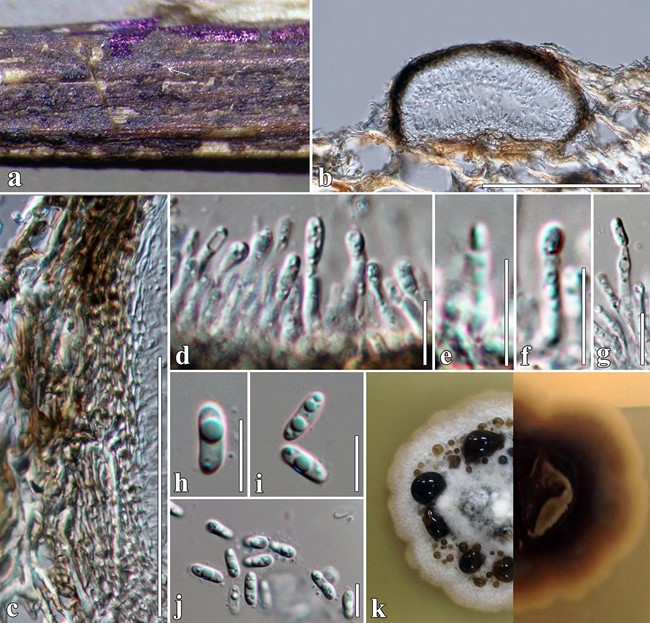Anthosulcatispora subglobosa Phukhams. & K.D. Hyde,sp. nov.
MycoBack number: MB 557203; Index Fungorum number: IF 557203; Facesoffungi number: FoF 07341; Fig. 73.
Etymology: Refers to the subglobose conidiomata.
Holotype: MFLU 17–1473.
Saprobic on dried stems of Clematis subumbellata. Sexual morph: Undetermined. Asexual morph: Conidiomata 160–210 × 265–345 μm ( x̄= 178 × 291 μm, n = 5), pycnidial, solitary, unilocular, scattered, shiny, immersed or erumpent, flattened base, subglobose to compressed, coriaceous, dark brown to reddish brown, lacking ostioles. Pycnidial wall 18–32 μm wide, thick, multilayered, composed of 10–14 brown layers of textura angularis, inner layer subhyaline, lining bearing conidiogenous cells. Conidiophores reduced to conidiogenous cells. Conidiogenous cells 5–17(–30) × 2–3.5 μm (x̄= 13 × 2.5 μm, n = 30), enteroblastic, phialidic, determinate, elongated cylindrical or truncate, smooth-walled, hyaline. Conidia 7–10 × 3–4 μm ( x̄= 8 × 4 μm, n = 50), oblong, rounded ends, hyaline, aseptate, with 1–3 guttules in each cell, smooth-walled, with mucilaginous sheath.
Cultural characters: Colonies on MEA reaching 30 mm diam. after 4 weeks at 25 °C. Cultures from above, cream at the centre, radiating, dense, circular, edge lobate, umbonate, papillate, fairly fluffy, covered with white aerial mycelium, black oil drops produced on the surface of cultures; reverse dark brown at the centre, faintly zonate, white at the edge.
Material examination: Thailand, Phayao Province, Phu Sang District, dead stems of Clematis subumbellata, 20 March 2017, C. Phukhamsakda, CMTH09 (MFLU 17–1473, holotype); ex-type living culture, MFLUCC 17–2065.
Host: Clematis subumbellata—(This study).
Distribution: Thailand—(This study).
GenBank accession numbers: LSU: MT214592; SSU: MT226705; ITS: MT310636; tef1: MT394649; rpb2: MT394706.
Notes: In a BLASTn search of GenBank, the closest match for LSU sequence of Anthosulcatispora subglobosa MFLUCC 17–2065 was Neobambusicola strelitziae (strain CBS 138869), (NG_058125) with 97% similarity, while the closest match for the ITS sequence of MFLUCC 17–2065 was Magnicamarosporium iriomotense (strain HHUF 30125), (NR_153445) with 89% similarity. Pairwise comparison of the ITS region showed that A. subglobosa differs from A. brunnea with 12% differences (76 base pairs difference of 585 base pairs, with gaps). The collection has oblong, hyaline, guttulate, and aseptate, with rounded ends conidia but microconidia were not observed in culture (Crous et al. 2014b; Rupcic et al. 2018). We also noted the formation of oil droplets in culture as a notable character for A. subglobosa (Fig. 73). Strain MFLUCC 17–2065 was evaluated for potential secondary metabolite production with Bacillus subtillis, Escherichia coli, Mucor plumbeus and Schizosaccharomyces pombe astest organisms. The isolate showed moderate growth inhibitory activities against Bacillus subtillis and Mucor plumbeus, and is thus a suitable candidate for further evaluation.

Fig. 73 Anthosulcatispora subglobosa (MFLU 17–1473, holotype). a Appearance of conidiomata on Clematis subumbellata. b Vertical section through conidioma. c Section of conidioma wall. d–g Conid- iogenous cells and conidia. h–j Conidia. k Culture characteristics on MEA. Scale bars: b = 100 µm, c = 50 µm, d–j = 10 µm
